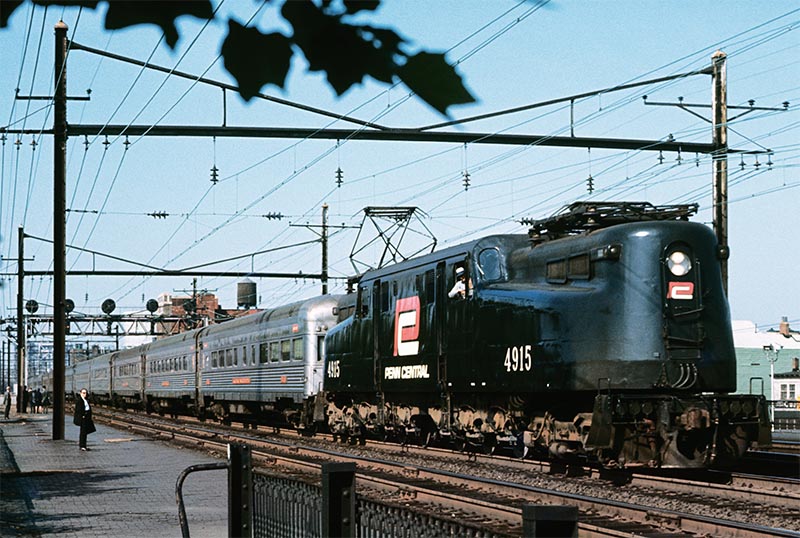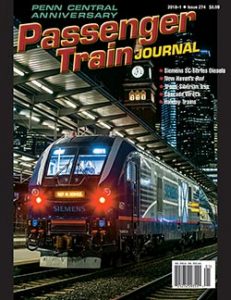February 1, 2018, marked the 50th anniversary of the merger of two eastern U.S. railroads, the Pennsylvania Railroad and the New York Central, to form the Penn Central Transportation Co. “Call us Penn Central,” urged the ads. Even today, the mere mention of the name can raise passions among those who worked for or patronized that railroad during its existence from 1968 to 1976. In this article, we will concentrate on PC’s passenger service, intercity and commuter, bearing in mind that this is just one aspect of the company’s problematic story, most of which has been discussed at length elsewhere.
The PC merger was only one of several that were begotten during the 1960s. Among these were the Norfolk & Western-Nickel Plate Road-Wabash amalgamation, the Baltimore & Ohio-Chesapeake & Ohio consolidation, and the Atlantic Coast Line and Seaboard Air Line merger. In these cases, there was a more profitable partner and/or the partners had not competed directly. ACL and SAL, for example, served many common markets, albeit over different routes. Apart from its sheer size, PC would fail on these points, and it had other shortcomings as well.
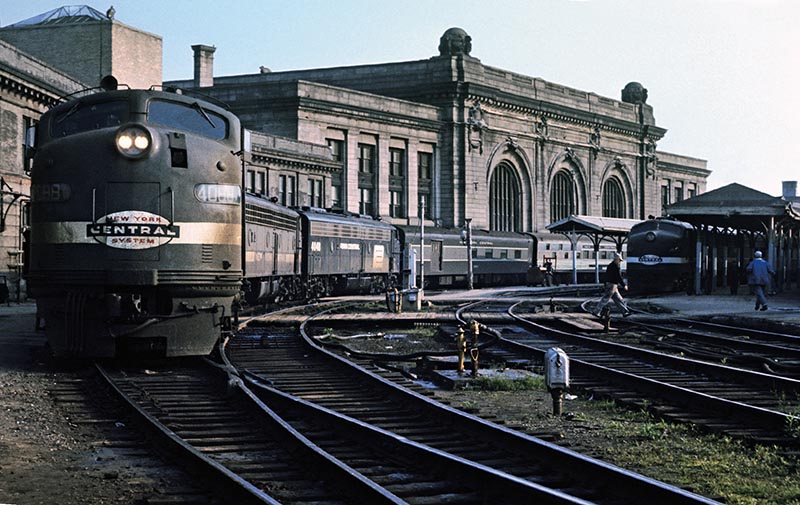
Deep in former NYC territory, PC train 8-62-28 out of Chicago—in essence the former New England States—pauses at Albany Union Station shortly after daybreak in June 1968. The Boston section, train 28, came off here; train 62 will continue on down the Hudson to New York City. Mike Schafer photo
As early as 1962, James Symes, an old Pennsy hand, was championing the NYC-PRR merger, and both boards of directors formally made the merger request. It appears that NYC was less enthusiastic, thinking that it had been frozen out of more desirable matches. As PC’s organizational structure was finalized, many promising managers jumped ship. Although NYC’s practices were more highly regarded by many in the industry, it became clear that Pennsy would prevail and become the dominant partner, electing a majority of the board and two of the three most senior executives. Chairman Stuart T. Saunders was an attorney brought over from Norfolk & Western to expedite the merger, and David C. Bevan, chairman of PC’s finance committee, was a former banker. From NYC came President Alfred E. Perlman, who had a wealth of railroad experience.
In the six years leading up to the PC merger, it appears that opportunities to effect a seamless transition were squandered, for as time passed, the financial health of the two railroads continued to decline. Nevertheless, it appeared that every union, government agency, regulator, shipper, and the stockholders demanded and frequently received concessions that would make a successful outcome less likely. In a final insult, regulators extorted a requirement for PC to take on an even more financially weak partner, the bankrupt New York, New Haven & Hartford, effective Jan. 1, 1969, adding to PC’s litany of problems. What were they thinking?
Penn Central’s managers believed that passenger service west of both Buffalo, N.Y., and Harrisburg, Pa., were financially hopeless cases. Most surviving trains either offered no amenities or provided minimal food service from snack bars.
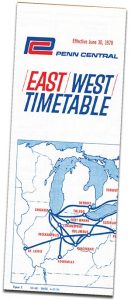 East/West Service
East/West Service
NYC’s passenger train rationalization had been completed as of 1968 and included a train between the East and Chicago that included a baggage-dorm, twin-unit diner with kitchen-lounge, Sleepercoach, and sleeper; a Sleepercoach and sleeper from Boston to Chicago, a sleeper from New York to Chicago via Detroit, (soon cut to New York–Detroit), a sleeper to Toronto, and a Sleepercoach from New York to Detroit. Dining cars were to be carried between Buffalo and Chicago and between Boston and Albany. A second train between New York and Chicago would carry a Sleepercoach to Buffalo and a sleeper to Cleveland. This train continued to Chicago in daylight with a dinerlounge. Thus, lots of overnight switching was needed, particularly in Buffalo. The James Whitcomb Riley between Chicago and Cincinnati, and an afternoon train each way between Chicago and Detroit retained full dining service.
On the Pennsy side, west of Harrisburg there were five trains to choose from. The best surviving train was the Broadway Limited, which had only recently acquired the coaches (and a coach-lounge purchased from the Rio Grande Railroad) from the General, which had been discontinued at the end of 1967. Four sleepers offered the usual roomettes and bedrooms but also duplex single rooms, compartments and drawing rooms, as well as a twin-unit diner, which all still made for a decent train.

With a freshly painted PC E8A and a grimy ex-NYC E7A on the point, westbound train No. 17 passes 99th Street on the former PRR main line on Chicago’s South Side early one afternoon in the summer of 1968. Only moments earlier, the train had gone through a see-saw back-up move to get from the ex-NYC main line to the Pennsy. Number 17 connected with New York/Boston–Albany–Buffalo–Cleveland–Chicago train 61-427-27 at Buffalo and operated to Chicago via the Canada Southern to Detroit and the old Michigan Central via Battle Creek and Kalamazoo, Mich. Mike Schafer photo
Two trains linking New York with St. Louis, the Spirit of St. Louis and Penn Texas, ran within three hours of each other. Between the two trains, diners ran either to St. Louis or Indianapolis, and each train carried sleepers to Indianapolis and St. Louis. One train carried a bedroom-lounge to Indianapolis and a sleeper to Cincinnati via a connection from Columbus. Another sleeper ran from Chicago to Washington via a connection from Harrisburg. A snack-bar coach ran from Washington to Harrisburg. An additional sleeper ran west on the Broadway but returned on a train overnight to Pittsburgh and as a daytime run to New York. Finally, there were two New York–Pittsburgh sleepers, including duplex single rooms.
On alternate days, the South Wind linked Chicago with Florida over the Pennsy to Louisville (see PTJ 2017-3); sleepers, a diner, and coach-lounge were operated with additional cars in the busier winter season.
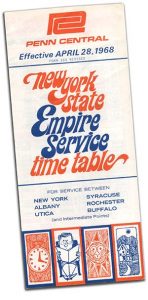 Empire Service
Empire Service
Turning again to the former NYC, its service between Grand Central Terminal, Albany, and Buffalo had only recently been reorganized as the Empire Service, a series of short regular trains on “memory schedules” and made up of refurbished cars including 40 coaches and 11 snack-bar coaches. Until all of the latter were ready, bedroom-parlor-lounges and tavern-lounges substituted.
Apart from two previously mentioned trains that carried cars for points beyond Buffalo, seven trains were scheduled. These included one train between Albany and Buffalo, three trains between New York and Buffalo, and three between New York and Albany. Day and night service was provided to Montreal via the Delaware & Hudson north of Albany. Through cars on the day train included a coach and a tavern-lounge in which lounge seats were sold as parlor seats. The night train carried coaches, one or two “10&6” sleepers, (10 roomette–6 double bedroom) and a bedroom-lounge car serving refreshments and a buffet breakfast.
What would become known as the Northeast Corridor (NEC) still provided through service between Washington, New York City and Boston over PC’s three component railroads.
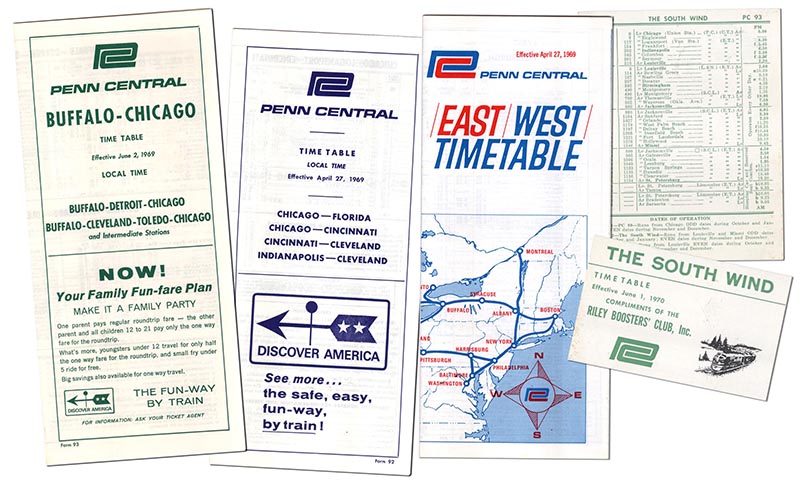
Sun and Sand Connections
Soon after merger day, Chesapeake & Ohio’s through service to and from cities served by PC was reduced to seasonal runs from the Greenbrier and Homestead resorts (at White Sulphur Springs, and Hot Springs, Va., respectively). Southern Railway operated two connecting trains with PC, offering coaches and sleepers from points as far as New Orleans. A through diner was operated between New York City and Atlanta on the Crescent to offer proper meal service for breakfast and dinner.
Seaboard Coast Line operated two through trains in conjunction with PC to and from Florida, the Champion and Silver Meteor. Peak winter service added the Florida Special and Silver Star. The Star ran year-round, but its shorter off-season consist was conveyed between New York and Washington as part of a regularly scheduled PC train. A summer Weekend Champion ran south to Jacksonville, Fla. PC carried through cars for SCL’s Silver Comet (to Birmingham, Ala.), Palmland, and Gulf Coast Special (serving the Carolinas and Florida).
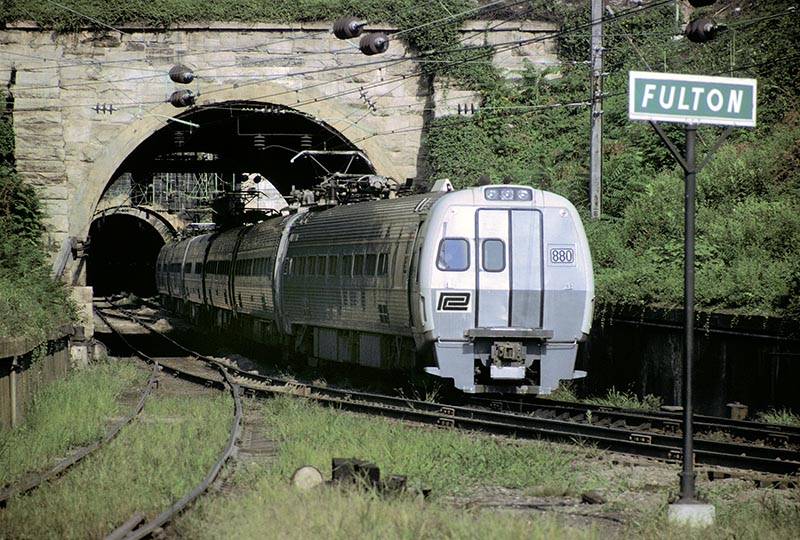
A Metroliner heads toward the B&P (Baltimore & Potomac) tunnels at Fulton in August 1970. Dale Jacobson photo
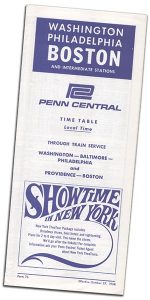 PC’s Corridor Service
PC’s Corridor Service
As Al Jolson said, “You ain’t seen nothin’ yet,” because we now turn to the Washington–Boston corridor, then as now, PC’s and Amtrak’s busiest intercity route. In 1968, the Metroliners were still in the midst of a long commissioning process, so nine Washington–New York and four Washington–Boston trains ran on roughly a 90-minute frequency. Several local trains linked Philadelphia with Washington, augmented by the famous “Clockers” leaving New York and Philadelphia “on the hour.”
Several additional frequencies served intermediate stations, and one of these was the longest scheduled train—all coaches except for a mid-train refreshment car. The Pennsy had a number of these cars and they also ran on North Jersey Coast and special trains.
Dining cars, with their high labor and supply costs, were an obvious target for savings. In 1967, ten modern parlor cars had been equipped to serve airline-style meals to first-class PRR passengers. The conventional diners remained until April 1968 but were then discontinued by PC, replaced by “Parlor Club Cars.” Coach passengers continued to be served in snack-bar coaches. Diners were retained on Boston–Washington trains and two New York–Washington round trips, which were scheduled to run to Boston on certain days. In 1969, six more parlor cars were converted into parlor-clubs and additional coaches were converted into snackbars; thereafter, the Senator became the last corridor train with a diner or grill car, usually former New Haven cars. Staffed by waitresses, NH’s popular grill diners were set up so that you sat on a bench seat with your back to the window, facing across the aisle to the tables and windows on the opposite side. The Senator’s two trainsets were assigned a New Haven baggage-lounge and parlor car.
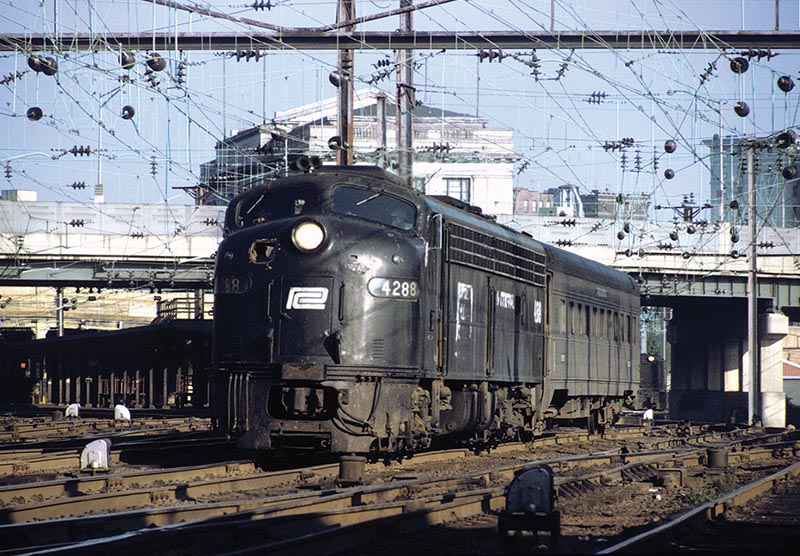
Heading for Harrisburg over the former PRR route via York, Pa., single-car train 549 departs Baltimore Penn Station in August 1970. At one time, this train operated overnight to Buffalo. Dale Jacobson photo
The “Clockers” still offered parlor service in a variety of car types, many of which PC took steps to replace; however retaining the four “blunt-ended” parlor-observations built by Budd in 1952 for the Congressional and Senator. Two pre-war NYC parlors were taken out of storage; though refurbished, some passengers complained about their glorified lounge seating, which was later converted by Amtrak to coach seating. Two Pennsy bedroom-lounges were redesignated and renumbered as parlor cars. These were supplemented by two coach-bar-lounge cars from the South Wind; parlor chairs replaced coach seating, and they were named John Adams and Thomas Jefferson, Nos. 7174–7175. Finally, six New Haven lounge cars—previously rebuilt with three drawing rooms for premium day use—exchanged their lounge seats for 19 single parlor chairs and were renumbered 7176–7181.
The best of the former Pennsy coaches included about 90 cars either built new or rebuilt from sleepers with a smoking lounge area, as well as 13 matching snack-bar coaches. Additional streamlined coaches were available if needed, as well as P70 coaches rebuilt between 1948 and 1952, which received new trucks, air-conditioning, and high-back walkover seats. These were fine-riding cars, perfectly adequate for Corridor service. Close to 80 still remained and another 30 examples received reclining seats and/ or snack-bars. Ninety-four long-distance coaches built by Altoona and ACF had proven to be a major disappointment and were well on the way out.
Initially, few cars were exchanged between their previous owners’ territory, but NYC contributed diners and lounges while PRR provided sleepers. Only a few PC cars were assigned to SCL or Southern Railway trains out of New York City, and these tended to be sleepers which presumably had been maintained to a higher standard. The South Wind, however, used a number of Pennsy cars.
Additionally, hundreds of former PRR X-29 boxcars, older NYC baggage cars, and former troop sleepers still in the fleet were no longer needed with the transfer of bulk mail to dedicated trains and the evaporation of express business…


